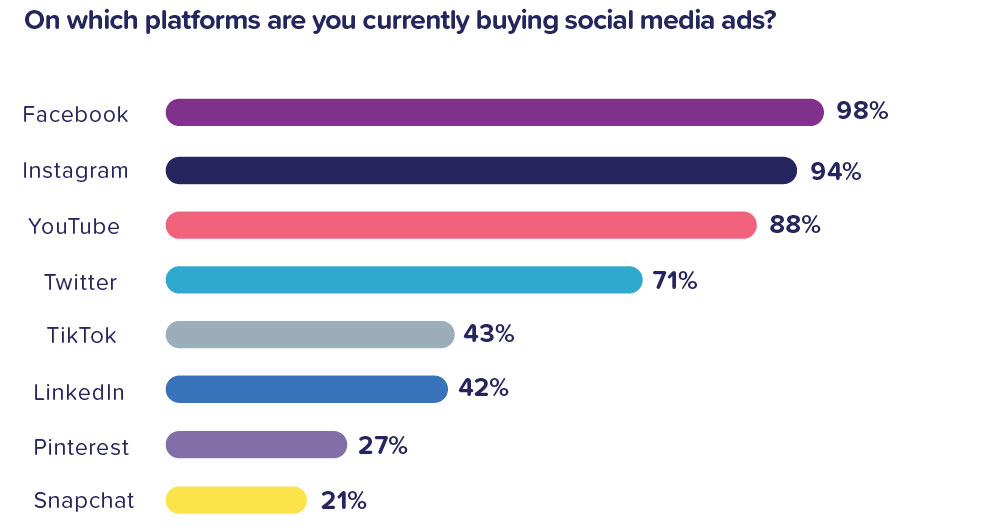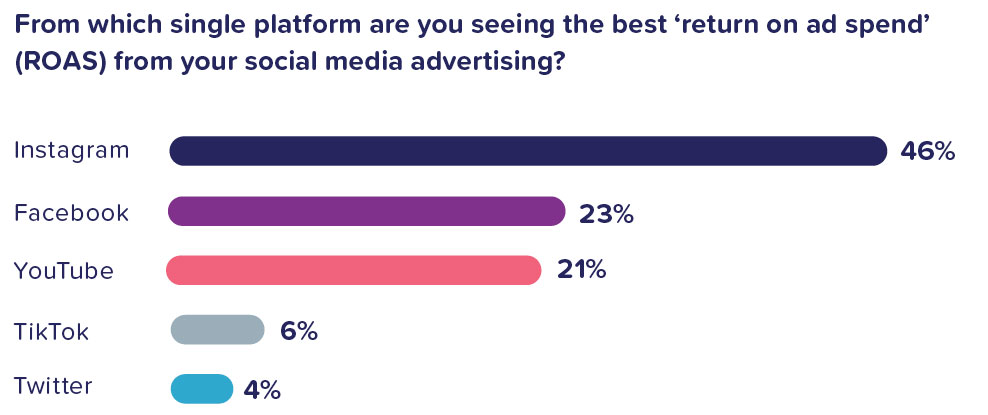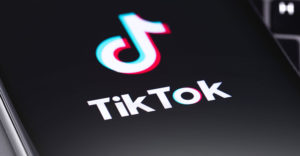Digital retailers are ramping up their social media advertising budgets to pitch products where shoppers gather socially. However, according to a report on the growing adoption of social advertising, brands need to employ automation strategies to replace traditional manual steps and add multi-platform approaches to remain successful.
New research from social advertising automation platform Smartly.io outlines how changes resulting from the global pandemic will impact ad spending and strategies social media platforms adopt this year. The company published its third annual “State of Social Advertising Report” in early January.
Smartly surveyed 100 leaders across the e-commerce, retail, gaming, travel, and financial services industries. The report examined year-over-year findings while exploring new trends that will continue to inform social advertising and marketing plans in 2022.
Smartly published a second version of the same study, “Global Social Advertising Trends 2022,” on its website. This study focused on how the world’s biggest brands plan their social advertising for the upcoming year.
B2C Firms Jockey for Social Attention
One of the most noticeable trends is the struggle many businesses face in adapting their digital-first marketing strategies to the return of consumer foot traffic into physical stores, according to that edition of the report.
Much of brands’ business remains online, and the digital trend shows few signs of slowing down. Digital advertising is critical for companies that depend on e-commerce and have forged digital-first fulfillment methods since the pandemic.
Social media is one of the primary spaces in which business-to-consumer companies compete for customer attention and loyalty. Today’s consumers use an average of eight social media platforms, so a multi-platform approach is essential for long-term success.
“We are not surprised to see more brands diversify their ad spend across multiple social platforms,” said Riikka Söderlund, global director of marketing at Smartly.io. “As more touchpoints become available, the consumer journey becomes more fragmented, making it even harder to predict and capture consumer attention.”
Confusing Double Treatment
The press release from Smartly distributed to the E-Commerce Times included a link to the same news release distributed on Business Wire. Both referenced a report titled the “State of Social Advertising Report.”
The press release also included an attached PDF report of the same study, now titled “Global Social Advertising Trends 2022.” The report versions were also available on the company’s website after filling in a request form eliciting business contact information from those requesting to download the PDF file.
On the first read, the PDF edition of the research appeared to be an expanded version of a related study the company conducted. The report provided more survey results and graphics, and the other report showed the data analysis. The research details were largely the same, but the overall content was presented differently.
The two report editions under two different titles suggested that the research paralleled two related studies. The E-Commerce Times contacted Smartly seeking clarification and comment on the study.
“We reference the report in slightly different ways in a couple of spots, but the State of Social Advertising Report and Global Social Advertising Trends 2022 Report are the same,” Andrés Warren, an assistant account executive at PAN Communications, told the E-Commerce Times.
Smartly did not respond to three other questions after confirming that the separate reports were based on a single study.
Splurging Social Ads Spend
The research highlighted fragmenting consumer journeys plus the expanding social media channels for advertising.
Researchers are seeing a multi-platform approach take center stage this year. Also, increased interest in automating at least parts of the social advertising process will help advertisers expand their reach. That will allow marketers to meet customers at every step and stage of their journey and communicate a cohesive brand story, according to Söderlund.
This year, many companies plan to increase advertising spending on social platforms more than they did last year. Facebook is still the advertising leader, with 98 percent of advertisers buying ads there. Respondents (87 percent) said they would increase ad spending there as well.
Instagram is one of the new go-to ad platforms, with 94 percent (up from 90 percent last year) of advertisers using the outlet. That was the biggest year-over-year jump, from 38 to 73 percent.

Source: Smartly.io | WBR Insights
TikTok, too, is seeing a drastic increase in ad revenue. Some 18 percent of respondents noted they will increase spending on that platform, an eight percent increase from last year.
Return on ad spend (ROAS) is also driving a clear shift in how marketers choose to allocate ad budgets on social media, the report revealed. For the second year in a row, Instagram saw the best ROAS from social ads (46 percent), up four percent from last year.

Source: Smartly.io | WBR Insights
Researchers found that as advertisers see ROAS, they allocate budgets accordingly, driving further diversification among platform spending.
Automation Left Lacking
Automation, though gaining in popularity as a way to remove steps from processes, needs to be utilized much more. Nearly three-quarters (73 percent) of respondents noted their social media advertising creation and delivery processes still involve time-consuming manual processes. Last year’s survey showed 72 percent said the same thing.
Almost the same number of respondents (69 percent) said they do not use automation technology for social media advertising creation, a drop from last year’s 81 percent. Equally noteworthy is only 17 percent of those now using automation technology say they are using it successfully.
This year, advertisers plan to:
- Use more creative automation (31 percent, up from 13 percent last year);
- Expand their in-house marketing teams to better manage social media advertising (29 percent);
- Outsource social media advertising more (29 percent);
- Invest more in social media advertising tools and tech (26 percent).
Conclusion
The Global Social Advertising Trends 2022 report shows that advertising on social media is still one of the most important methods for building brands and connecting with customers.
Companies dedicate significant portions of their marketing budgets to social media advertising, but they are also devoting more resources to social media channels that have yielded strong returns.
Instagram is one of the most sought-after platforms for social media advertising among consumer-facing companies. Organizations that intend to compete for both attention and loyalty must not ignore this channel.
However, the report also indicates that consumer-facing businesses are still struggling with certain aspects of their advertising. The process of developing and creating advertisements is mired by manual processes. Many companies also say they struggle to coordinate with their creative teams to develop meaningful creative assets that align with their campaigns.
To overcome these issues, companies must adopt automation tools that streamline the processes of developing, creating, and managing their social media advertising campaigns. They need to identify and leverage turnkey services that use both data and human creativity to produce compelling ads.
This represents the future of social media advertising, and it will provide companies with the edge they need to stand out in a noisy marketplace.
The State of Social Advertising Report, however, did not present those conclusions.





























































Social Media
See all Social Media